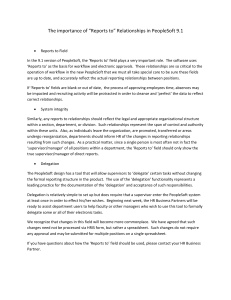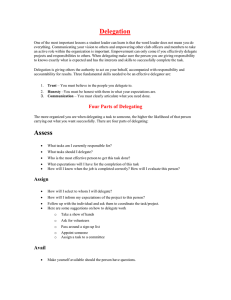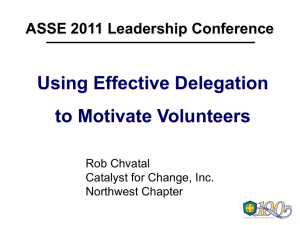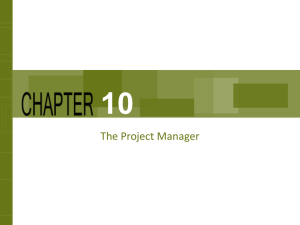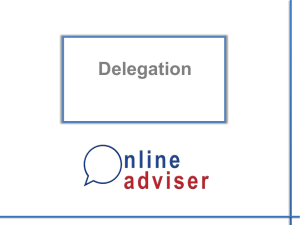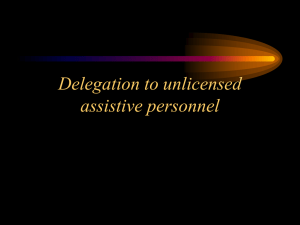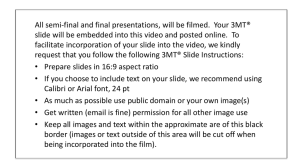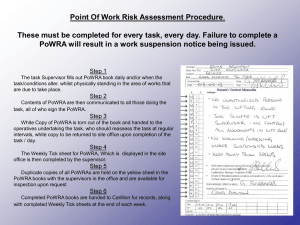Delegating - Advocate Health Care
advertisement
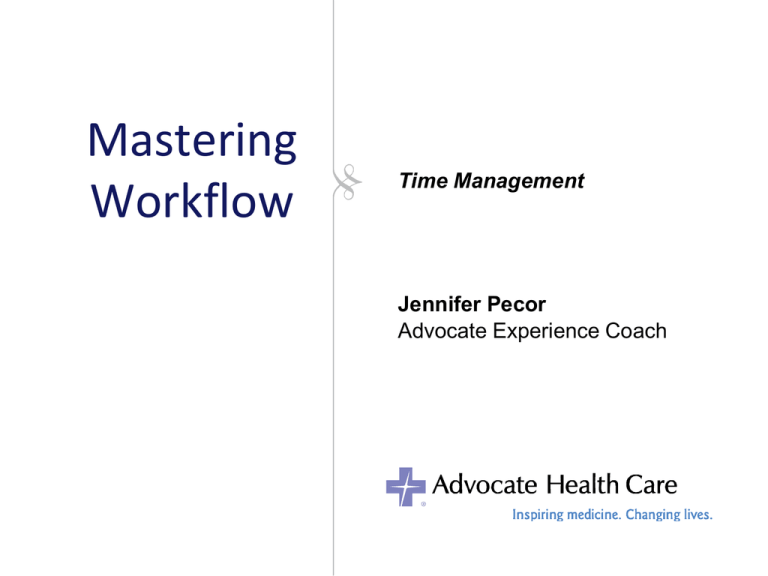
Mastering Workflow Time Management Jennifer Pecor Advocate Experience Coach The big problem is that your mind keeps reminding you of things when you can’t do anything about them. “Multi tasking when it comes to paying attention, is a myth.” - Dr. John Medina People who are interrupted: Take 50% longer to complete a task. Make 50% more errors. The 5 Steps: 1. 2. 3. 4. 5. Collect Process Organize Review Do Step 1: Collecting Gathering 100% of the incomplete “stuff.” Gather representations for each of these items; whatever captures input for you best. As soon as you attach a “should,” “need to,” or “ought to,” it becomes an incomplete. Collecting involves both physical gathering and mental gathering. The mental gathering, or “mind sweep,” involves writing down each thought, idea, project or thing that has your attention on a separate sheet of paper. Exercise Take out your lists – including the one from this morning. Take out your calendar. Spend 10 minutes gathering all of your incomplete work “stuff:” – I “should be working on…” – I “need to…” – I “am going to… Step 2: Process Processing does not mean “spend time on it.” Processing means ”decide what the next thing is and what action is required, and then dispatch it accordingly.” Rules for Processing Process the top item first. Process one item at a time. Never put anything back into “in.” The Key Processing Question What’s the next action? If there is no next action required, there are 3 possibilities: – Trash/delete – Someday/maybe – Reference The Key Processing Question What’s the next action? The next action is the next physical, visible activity that needs to be engaged in, in order to move the current reality towards completion. Do it, delegate it, or defer it. Exercise In pairs, select five items from your “collection” list and decide: 1. What is it? 2. Is it actionable? 3. If yes – decide the very next physical action required. Step 3: Organize 4 Key Action Categories Projects Calendar Next Actions Waiting For Review Daily Review: Calendar and Next Actions list. Weekly Review: Projects, Next Actions, Waiting For and Someday/Maybe. Do “Every decision to act is an intuitive one. The challenge is to migrate from hoping it’s the right choice to trusting it’s the right choice.” Do The four criteria model for choosing action in the moment: Context Time available Energy available Priority Delegation Delegation is primarily about… “Assigning a task that you currently have in your activity list (for which you are ultimately responsible) and assigning it to other person with confidence that he/she will complete with minimal or no involvement from you.” Delegation or Work Assignment? Assigning Work - Supervisor tells employee what the assignment is - Supervisor tells employee what the completed assignment should look like - Supervisor tells employee how to do the assignment - Supervisor offers support and help in carrying out the assignment - Supervisor follows up to check on progress of assignment Delegating - Supervisor tells employee what results are required - Employee determines what completed assign should look like - Employee decides how to do the assignment - Supervisor offers support in planning assignment and achieving results - Supervisor follows up on planning and progress Delegation Roadblocks - I can do it better myself - I can’t trust my workers - I don’t have time to involve others - I can’t delegate something I don’t know how to do myself - I can’t bring myself to delegating busy work - I can’t delegate to my friends - Everyone is already busy LOSS OF CONTROL Resistance to Delegation - They don’t know how to do the task - They have a fear of criticism for mistakes - They lack confidence in their ability - They don’t understand what is wanted - They don’t have the time - They don’t like doing it. When to Delegate - When somebody else is more skilled in the task than you - When an individual has approached you with willingness to help on a specific project - When someone can develop himself or herself by taking on a challenging task - When you don’t have the time to handle your other responsibilities effectively - When planning takes more time than implementing When Not to Delegate - When the person has a negative attitude about the task - When the person is too busy to complete the task - When the person cannot handle the responsibility - When you will have to change the person’s attitudes or behaviors Why Delegation? • • • • • Development of Personnel Helps in Time Management Increasing Total Power of manager/leader and organization Demonstrates professionalism and effectiveness Creates a win-win situation Develops a sense of accomplishment, trust, opportunity to grow and gain recognition. Steps of Successful Delegation 1 9 Feedback on results 8 7 Agree to deadlines 6 5 Consider resources required State required results 4 3 Support and communicate Explain the reasons Assess ability and training needs 2 1 Select the individual or team Define the task
